Get free scan and check if your device is infected.
Remove it nowTo use full-featured product, you have to purchase a license for Combo Cleaner. Seven days free trial available. Combo Cleaner is owned and operated by RCS LT, the parent company of PCRisk.com.
What is the "Order Error" scam email?
"Order Error" is an spam email campaign. This term defines a mass-scale operation during which thousands of deceptive emails are distributed. There are several variants of the "Order Error" scam emails, however, the messages are thematically identical. They are presented as messages sent by a wrongly charged customer/buyer, with the recipient positioned as the seller.
Note that these emails are scams, and none of the information provided by them is genuine. The purpose of this campaign is to promote a phishing/malicious site, and so visiting and trusting it can cause serious issues.
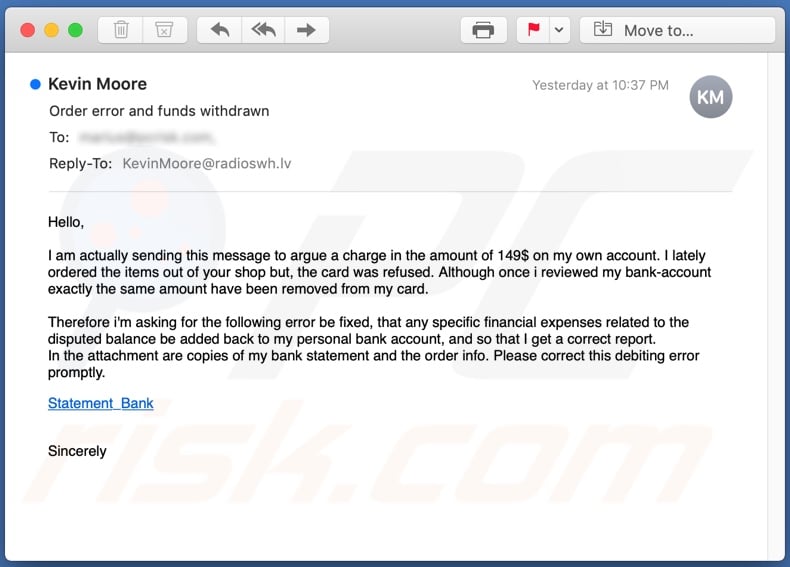
The "Order Error" scam messages (subjects/titles "Order error and funds withdrawn" or "Purchase malfunction and funds withdrawn", depending on the variant) are presented as payment charge disputes.
The emails state that the sender, who is the supposed buyer in the scam's scenario, has attempted to purchase products from the recipient's shop but failed to do so due to their credit card being declined. Yet, despite the failing to make the order, the corresponding sum (US$149 or US$337, depending on the message version) has been charged from the recipient's bank account.
The emails ask the recipient to rectify the issue and return the wrongly charged amount. As 'proof', the messages include a link allegedly leading to the relevant bank statement. As mentioned, the "Order Error" messages are fake, and the website linked inside them does not lead to any bank statement.
Deceptive emails like "Order Error" are typically used to promote various phishing and malicious websites. The former are designed to record any data entered into them. These sites are often disguised as log-in web pages to legitimate services (e.g., as sign-in pages of real online bank accounts).
In this way, information provided to phishing websites (e.g., names, surnames, addresses, emails, telephone numbers, usernames, passwords, banking account and credit card details, etc.) is revealed to the scammers. Upon accessing the malicious sites, they trigger the infection chain (i.e., download/installation) of malware.
Such websites are commonly used to spread Trojans, ransomware, cryptominers, and other malicious programs.
In summary, by trusting the "Order Error" scam emails, users can experience system infections, serious privacy issues, financial losses, and even identity theft.
| Name | Order Error Email Scam |
| Threat Type | Phishing, Scam, Social Engineering, Fraud |
| Fake Claim | Scam emails are presented as order disputes. |
| Symptoms | Unauthorized online purchases, changed online account passwords, identity theft, illegal access of the computer. |
| Distribution methods | Deceptive emails, rogue online pop-up ads, search engine poisoning techniques, misspelled domains. |
| Damage | Loss of sensitive private information, monetary loss, identity theft. |
| Malware Removal (Windows) |
To eliminate possible malware infections, scan your computer with legitimate antivirus software. Our security researchers recommend using Combo Cleaner. Download Combo CleanerTo use full-featured product, you have to purchase a license for Combo Cleaner. 7 days free trial available. Combo Cleaner is owned and operated by RCS LT, the parent company of PCRisk.com. |
"Banco De Espana Email Scam", "Email Disabling Service", "N26 Email Scam", "I Monitored Your Device On The Net For A Long Time", and "Credito Agricola Email Scam" are some examples of other spam campaigns. The messages distributed through these massive operations are usually presented as "official", "important", "urgent", "priority", and similar.
As well as being used for phishing, spam campaigns are also employed for other scams and malware proliferation. The sole purpose of scam emails is to generate revenue at users' expense. Due to spam mail's relative prevalence, you are strongly advised to exercise caution with incoming emails.
How do spam campaigns infect computers?
Typically, cyber criminals behind malspam campaigns send emails with a file attached to them or a download link to the malicious file. Their main goal is to trick recipients into opening/executing the rogue file, which then installs malicious software.
Some examples of files that cyber criminals send via email are Microsoft Office and PDF documents, executables (.exe), JavaScript, and archives (ZIP, RAR).
Note that malicious documents that are opened with Microsoft Office 2010 or newer versions install malicious software only if users enable macros commands (enable editing/content). These versions include "Protected View" mode, which does not allow opened malicious documents to install malware automatically. Older versions do not include this feature and install malicious software without asking permission.
How to avoid installation of malware
To avoid infecting the system with malware spread through spam mail, you are strongly advised not to open suspicious or irrelevant emails, especially those with any attachments or links present in them. Use official and verified download channels.
Additionally, all programs must be activated and updated with tools/functions provided by legitimate developers, since illegal activation tools ("cracks") and third party updaters commonly proliferate malicious software.
To ensure device integrity and user safety, it is paramount to have reputable anti-virus/anti-spyware software installed and kept updated. Furthermore, use these programs to run regular system scans and to remove detected/potential threats.
Do not trust irrelevant emails that contain attachments or website links, especially if received from unknown, suspicious addresses.
Fake update tools infect systems by installing malicious programs rather than updates/fixes for installed software, or by exploiting bugs/flaws of outdated software that is installed on the computer.
Further encryption of any unaffected files can be prevented by uninstalling the ransomware, however, already compromised files remain encrypted even after removal of the rogue software and can only be recovered from a backup.
If you have already opened malicious attachments, we recommend running a scan with Combo Cleaner Antivirus for Windows to automatically eliminate infiltrated malware.
Text presented in the "Order Error" scam email message:
Subject: Order error and funds withdrawn
Hello,
I am actually sending this message to argue a charge in the amount of 149$ on my own account. I lately ordered the items out of your shop but, the card was refused. Although once i reviewed my bank-account exactly the same amount have been removed from my card.
Therefore i'm asking for the following error be fixed, that any specific financial expenses related to the disputed balance be added back to my personal bank account, and so that I get a correct report.
In the attachment are copies of my bank statement and the order info. Please correct this debiting error promptly.
Statement_Bank
Sincerely
Screenshot of the alternative variant of the "Order Error" email (subject "Purchase malfunction and funds withdrawn"):
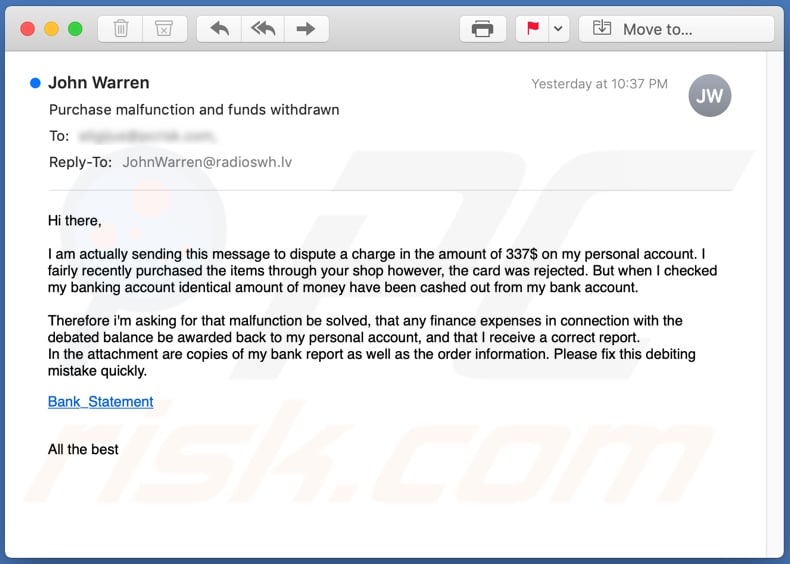
Text presented in this variant:
Subject: Purchase malfunction and funds withdrawn
Hi there,
I am actually sending this message to dispute a charge in the amount of 337$ on my personal account. I fairly recently purchased the items through your shop however, the card was rejected. But when I checked my banking account identical amount of money have been cashed out from my bank account.
Therefore i'm asking for that malfunction be solved, that any finance expenses in connection with the debated balance be awarded back to my personal account, and that I receive a correct report.
In the attachment are copies of my bank report as well as the order information. Please fix this debiting mistake quickly.Bank_Statement
All the best
Yet another variant of Order Error scam email:
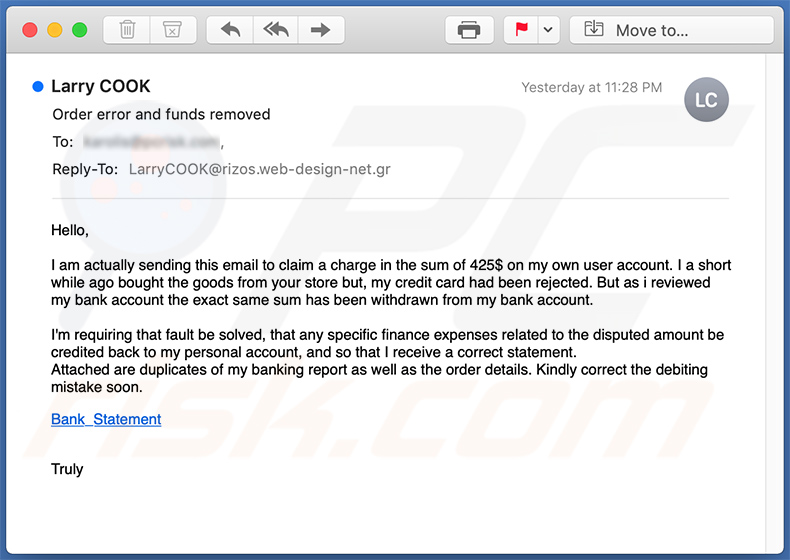
Text presented within:
Subject: Order error and funds removed
Hello,
I am actually sending this email to claim a charge in the sum of 425$ on my own user account. I a short while ago bought the goods from your store but, my credit card had been rejected. But as i reviewed my bank account the exact same sum has been withdrawn from my bank account.
I'm requiring that fault be solved, that any specific finance expenses related to the disputed amount be credited back to my personal account, and so that I receive a correct statement.
Attached are duplicates of my banking report as well as the order details. Kindly correct the debiting mistake soon.
Bank_Statement
Truly
Yet another example of order error-themed spam (the link within downloads a malicious MS Excel document):
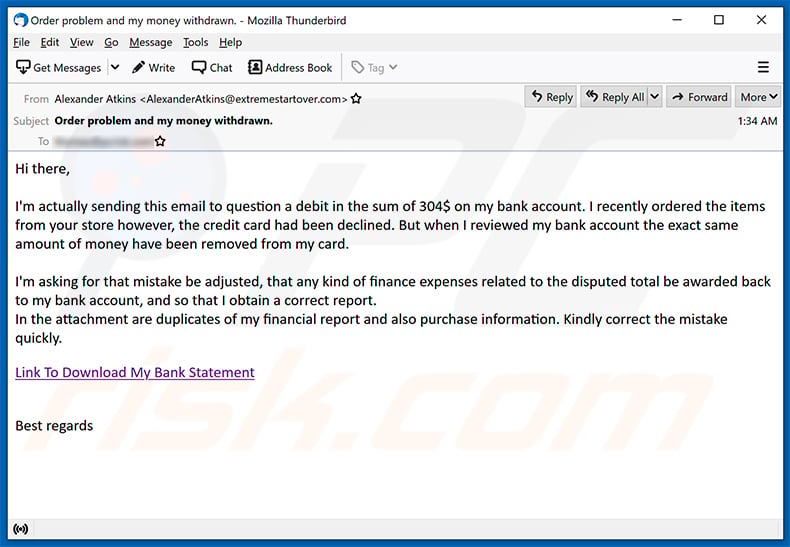
Text presented within:
Subject: Order problem and my money withdrawn.
Hi there,I'm actually sending this email to question a debit in the sum of 304$ on my bank account. I recently ordered the items from your store however, the credit card had been declined. But when I reviewed my bank account the exact same amount of money have been removed from my card.
I'm asking for that mistake be adjusted, that any kind of finance expenses related to the disputed total be awarded back to my bank account, and so that I obtain a correct report.
In the attachment are duplicates of my financial report and also purchase information. Kindly correct the mistake quickly.Link To Download My Bank Statement
Best regards
Screenshot of the distributed MS Excel document (used to inject malware into the system):
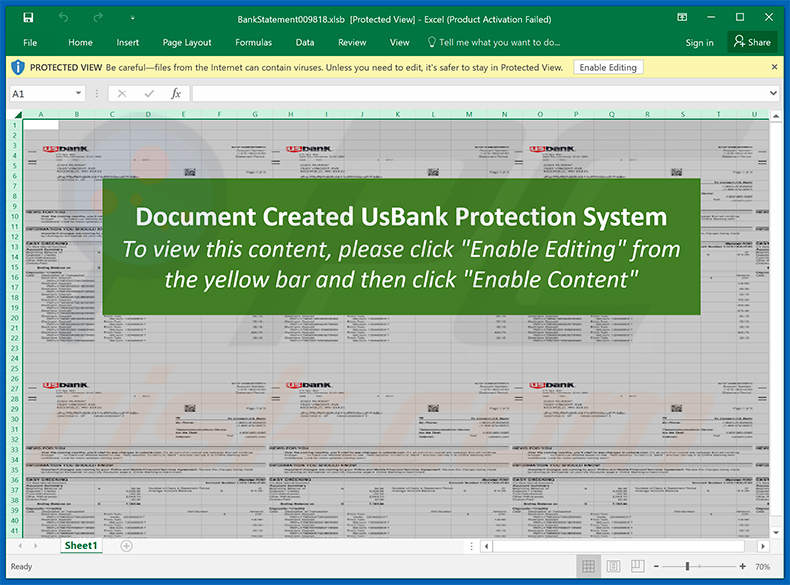
Another spam email spreading an identical MS Excel document:
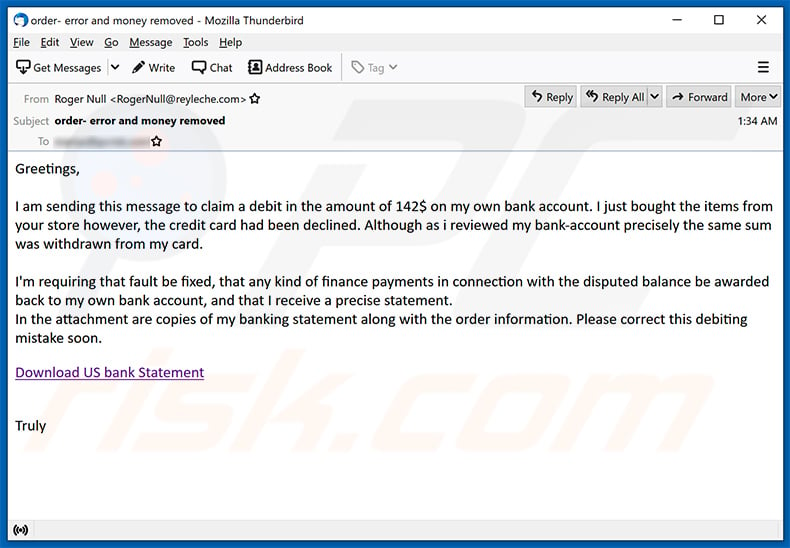
Text presented within:
Subject: order- error and money removed
Greetings,I am sending this message to claim a debit in the amount of 142$ on my own bank account. I just bought the items from your store however, the credit card had been declined. Although as i reviewed my bank-account precisely the same sum was withdrawn from my card.
I'm requiring that fault be fixed, that any kind of finance payments in connection with the disputed balance be awarded back to my own bank account, and that I receive a precise statement.
In the attachment are copies of my banking statement along with the order information. Please correct this debiting mistake soon.Download US bank Statement
Truly
Instant automatic malware removal:
Manual threat removal might be a lengthy and complicated process that requires advanced IT skills. Combo Cleaner is a professional automatic malware removal tool that is recommended to get rid of malware. Download it by clicking the button below:
DOWNLOAD Combo CleanerBy downloading any software listed on this website you agree to our Privacy Policy and Terms of Use. To use full-featured product, you have to purchase a license for Combo Cleaner. 7 days free trial available. Combo Cleaner is owned and operated by RCS LT, the parent company of PCRisk.com.
Quick menu:
- What is Order Error spam?
- Types of malicious emails.
- How to spot a malicious email?
- What to do if you fell for an email scam?
Types of malicious emails:
![]() Phishing Emails
Phishing Emails
Most commonly, cybercriminals use deceptive emails to trick Internet users into giving away their sensitive private information, for example, login information for various online services, email accounts, or online banking information.
Such attacks are called phishing. In a phishing attack, cybercriminals usually send an email message with some popular service logo (for example, Microsoft, DHL, Amazon, Netflix), create urgency (wrong shipping address, expired password, etc.), and place a link which they hope their potential victims will click on.
After clicking the link presented in such email message, victims are redirected to a fake website that looks identical or extremely similar to the original one. Victims are then asked to enter their password, credit card details, or some other information that gets stolen by cybercriminals.
![]() Emails with Malicious Attachments
Emails with Malicious Attachments
Another popular attack vector is email spam with malicious attachments that infect users' computers with malware. Malicious attachments usually carry trojans that are capable of stealing passwords, banking information, and other sensitive information.
In such attacks, cybercriminals' main goal is to trick their potential victims into opening an infected email attachment. To achieve this goal, email messages usually talk about recently received invoices, faxes, or voice messages.
If a potential victim falls for the lure and opens the attachment, their computers get infected, and cybercriminals can collect a lot of sensitive information.
While it's a more complicated method to steal personal information (spam filters and antivirus programs usually detect such attempts), if successful, cybercriminals can get a much wider array of data and can collect information for a long period of time.
![]() Sextortion Emails
Sextortion Emails
This is a type of phishing. In this case, users receive an email claiming that a cybercriminal could access the webcam of the potential victim and has a video recording of one's masturbation.
To get rid of the video, victims are asked to pay a ransom (usually using Bitcoin or another cryptocurrency). Nevertheless, all of these claims are false - users who receive such emails should ignore and delete them.
How to spot a malicious email?
While cyber criminals try to make their lure emails look trustworthy, here are some things that you should look for when trying to spot a phishing email:
- Check the sender's ("from") email address: Hover your mouse over the "from" address and check if it's legitimate. For example, if you received an email from Microsoft, be sure to check if the email address is @microsoft.com and not something suspicious like @m1crosoft.com, @microsfot.com, @account-security-noreply.com, etc.
- Check for generic greetings: If the greeting in the email is "Dear user", "Dear @youremail.com", "Dear valued customer", this should raise suspiciousness. Most commonly, companies call you by your name. Lack of this information could signal a phishing attempt.
- Check the links in the email: Hover your mouse over the link presented in the email, if the link that appears seems suspicious, don't click it. For example, if you received an email from Microsoft and the link in the email shows that it will go to firebasestorage.googleapis.com/v0... you shouldn't trust it. It's best not to click any links in the emails but to visit the company website that sent you the email in the first place.
- Don't blindly trust email attachments: Most commonly, legitimate companies will ask you to log in to their website and to view any documents there; if you received an email with an attachment, it's a good idea to scan it with an antivirus application. Infected email attachments are a common attack vector used by cybercriminals.
To minimise the risk of opening phishing and malicious emails we recommend using Combo Cleaner Antivirus for Windows.
Example of a spam email:

What to do if you fell for an email scam?
- If you clicked on a link in a phishing email and entered your password - be sure to change your password as soon as possible. Usually, cybercriminals collect stolen credentials and then sell them to other groups that use them for malicious purposes. If you change your password in a timely manner, there's a chance that criminals won't have enough time to do any damage.
- If you entered your credit card information - contact your bank as soon as possible and explain the situation. There's a good chance that you will need to cancel your compromised credit card and get a new one.
- If you see any signs of identity theft - you should immediately contact the Federal Trade Commission. This institution will collect information about your situation and create a personal recovery plan.
- If you opened a malicious attachment - your computer is probably infected, you should scan it with a reputable antivirus application. For this purpose, we recommend using Combo Cleaner Antivirus for Windows.
- Help other Internet users - report phishing emails to Anti-Phishing Working Group, FBI’s Internet Crime Complaint Center, National Fraud Information Center and U.S. Department of Justice.
Share:

Tomas Meskauskas
Expert security researcher, professional malware analyst
I am passionate about computer security and technology. I have an experience of over 10 years working in various companies related to computer technical issue solving and Internet security. I have been working as an author and editor for pcrisk.com since 2010. Follow me on Twitter and LinkedIn to stay informed about the latest online security threats.
PCrisk security portal is brought by a company RCS LT.
Joined forces of security researchers help educate computer users about the latest online security threats. More information about the company RCS LT.
Our malware removal guides are free. However, if you want to support us you can send us a donation.
DonatePCrisk security portal is brought by a company RCS LT.
Joined forces of security researchers help educate computer users about the latest online security threats. More information about the company RCS LT.
Our malware removal guides are free. However, if you want to support us you can send us a donation.
Donate
▼ Show Discussion